
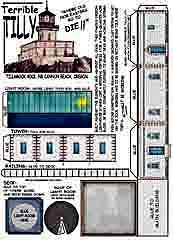
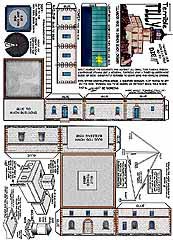
Tillamook Rock, OR - $$5.95
Twenty miles south of the entrance to the Columbia River, Tillamook Head towers above the often restless waters of the wide Pacific. Generations of approaching mariners have guided on its lofty profile to reach a safe haven. In 1878, Congress decided to erect a lighted beacon atop the 1,000-foot promontory-to give it round-the-clock visibility.
Tillamook Rock Lighthouse
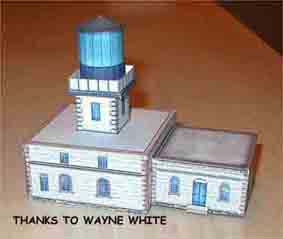
Twenty miles south of the entrance to the Columbia River, Tillamook Head towers above the often restless waters of the wide Pacific. Generations of approaching mariners have guided on its lofty profile to reach a safe haven. In 1878, Congress decided to erect a lighted beacon atop the 1,000-foot promontory-to give it round-the-clock visibility. Over the next three years, lawmakers voted a series of appropriations for a "first-class lighthouse and steam fog signal." Before anything happened, however, Lighthouse Board engineers reminded officials that the soaring headland was often obscured by pesky fog and suggested a less lofty location would be more appropriate. And since Tillamook Head's sheer ocean face made it impractical to locate anything on it, attention focused on nearby Tillamook Rock. The wave-battered basalt outcropping rises abruptly from the sea, 1.5 miles offshore. It was an optimum spot for a light, although the task of building anything on the exposed site would prove an incalculable challenge.
Tillamook Rock Lighthouse
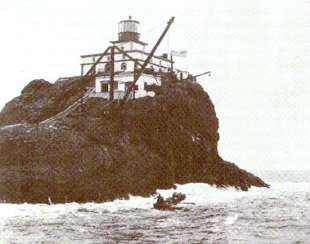
Prior to construction, crews had to remove the entire crown
of the humpbacked ledge and create a level building surface. Single
charges of black powder-100 pounds (and more) at once-ultimately
loosened more than 4,600 cubic yards of stubborn stone. On the
newly created plane, 100 feet above sea level, workers began constructing
a combination lighthouse, living quarters, and fog signal station.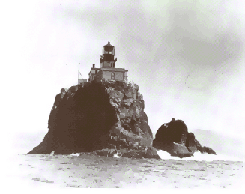
Crews lived and worked in wretched conditions for weeks and months at a time, often enduring the wildest conditions imaginable. But, in what the Lighthouse Board termed a "remarkable engineering feat," they overcame all odds, including the dire predictions of many skeptics ashore, to complete a brick-lined, sandstone structure as rugged as any fortress. The square lighthouse, rising 35 feet above the rock, went into service 21 January 1881, showing a flashing white light 133 feet above the sea.
Life on "Terrible Tilly," as the rock came to be known, was difficult at best, although l lighthouse Service-and later Coast Guard- personnel faithfully manned the solitary sentinel for more than three quarters of a century. Ultimately, the immense costs of ongoing maintenance forced the government to close the station and replace the light with an automated buoy anchored 1,000 feet to the northwest. The changeover took place 10 September 1957.
Since then, the lighthouse has been sold four times. The first
three owners could do little or nothing to rejuvenate the steadily
decaying structure. In 1980, a group of Portland investors purchased
the light for $50,000, had it stripped and sealed shut, converting
the facility into the Eternity at Sea Columbarium-a unique resting
place for ashes of the deceased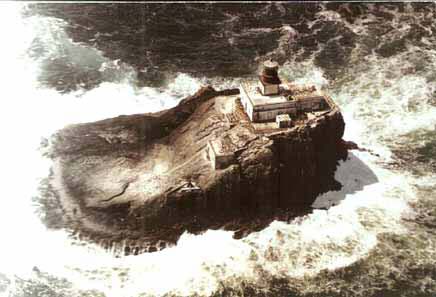
Viewing spot: The closest views (which require a two-mi, one-way hike) are found along the Oregon Coast Trail, between Ecola State Park and Seaside; somewhat more distant views are possible from the Indian Beach parking area, Ecola State Park. From viewpoints along the coast trail, the lighthouse is visible 1.5 miles to the W; from Indian Beach, it's 2.0 miles to the NW
Directions: From US 101, just north of Cannon Beach turn west onto Beach Dr (signs for Ecola State Park) and proceed 0.3 miles. Turn right onto E 5th St and continue 0 15 miles. Turn right onto Ecola State Park Rd and continue to the park entrance booth (seasonal day-use fee). Bear right and continue to the Indian Beach parking area. The trail begins at a gated road on the right-hand side of the turn around.
The only Oregon lighthouse built on a rocky islet offshore, Tillamook Rock Lighthouse with its 62-foot tower can be seen a little more than a mile off Tillamook Head. Building this was an engineering feat and a nightmare for the workers who were often buffeted by waves washing completely over the rock and by hurricane force winds; they were often cut off from supply ships for weeks. at a time. Once the lighthouse was built it received the largest Fresnel lens-a first order light. It shone almost continuously from the time it was lit on January 1881 until September 1957 when the lighthouse was decommissioned and replaced by a buoy.

During its 76 years of service, Tillamook Rock was always manned- never automated. But for the light house keepers stationed there, it was an isolated and lonely existence. Fortunately, there were usually four of them with three always on duty.
Storms caused considerable damage, even knocking out panes of glass from the lantern room from time to time. Among the cleanup following the October 21, 1934, storm was "seaweed, fish, and rock fragments," wrote lighthouse author Jim Gibbs . This is one of many books on Pacific Coast lighthouses and shipwrecks that Gibbs has authored including two on Tillamook Rock Lighthouse. He was stationed there as a keeper while in the Coast Guard during 1945-46 and says that none of the men stationed there ever ventured outside during severely stormy weather and that they never called it "Terrible Tilly." That moniker appeared after it was abandoned.
Several years ago Tillamook Rock Lighthouse was bought by Eternity at Sea, which turned it into a columbarium. It has also been placed on the National Register of Historic Places, which allows for exterior painting. Otherwise Tillamook Rock, which is overseen by the U.S. Fish and Wildlife Service, has returned to being like it was before the lighthouse was built. Seals and sea lions often occupy the lower portions of the eastern slope, and murres and gulls whiten the rock with their droppings.
The lighthouse is not open to the public, but can be seen from Ecola State Park and Highway 101 south of Cannon Beach.


